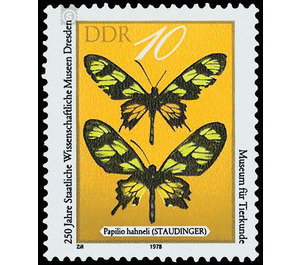250 years - Germany / German Democratic Republic 1978 - 11 Pfennig
| Country | Germany / German Democratic Republic |
| Issue Date | 1978 |
| Face Value | 11.00 |
| Color | brown orange |
| Perforation | K 14 |
| Printing Type | Rotogravure 2 |
| Stamp Type | Postage stamp |
| Item Type | Stamp |
| Chronological Issue Number | 2112 |
| Chronological Chapter | GER-DDR |
| SID | 617175 |
| In 26 Wishlists | |
250 years of the Staatliche Wissenschaftliche Museen Dresden On the occasion of the 250th anniversary of the existence of the Staatliche Wissenschaftliche Museen Dresden, the Ministry of Posts and Telecommunications of the German Democratic Republic issues six multicolored special postage stamps. Special cancellations from October 24 to December 23, 1978 250th anniversary of the Staatliche Wissenschaftliche Museen Dresden In October 1978, the three Dresden Science Museums - The State Museum of Animal Science (10 and 20 Pfennig value), the State Museum of Mineralogy and Geology ( 25- and 35-pfennig value) and the State Mathematical-Physical Salon (40- and 50-pfennig value) its 250th anniversary. For this reason, these six special postage stamps appear with representations of rare exhibits from the individual collections of these museums. With the dissolution of the Electoral Saxon Kunstkammer in 1728, these museums became independent; It was only after the division of the extensive, very diverse holdings that the arbitrary and unscientific accumulated collections of representations of the private feudal rarity chamber gradually developed into public, scientifically directed and also evaluated collections. These museums, which have been research centers for years, are today among the most famous and well-known museums in the world within their scientific disciplines. The Papilio hahneli, described by Staudinger in 1882 and depicted on the 10 Pfennig value, belongs to the family of the Knights or Sailor's Warblers (Papilionidae) and was founded in 1880 by the famous traveler and butterfly collector. Paul Hahnel discovered near Massauary on the Rio Manes in the Amazon and named him in his honor. Only a few pieces were found at that time, and to this day the number of animals of this species present in the museums of the world has remained very small, so that it can be counted among the treasures of each collection. The National Museum of Animal Science Dresden has two specimens from the original find area of the Rio Manes, which are owned by the well-known Dresdner Südamerikareisenden Dr. med. S. Wähner were later captured there and came to the museum with his collection.


